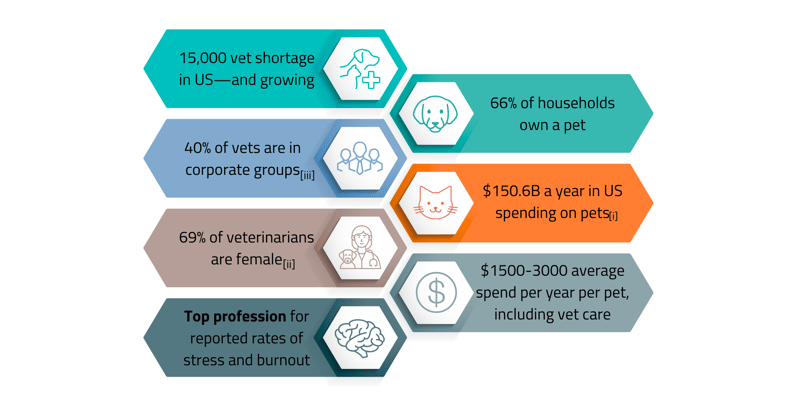For years, medical device, diagnostics and pharmaceutical companies have approached the veterinary market with caution, assuming extreme cost consciousness. In reality, this market is fast-growing and underserved. End customer behavior has changed, demonstrating an eagerness for solutions that improve quality of life for the companion animals they now consider family members.

COVID spurred pet adoptions, and those pet owners, the majority of which are Millenials, are increasing the demand in the veterinary industry. From personalized food and medicine to diagnostics and chemotherapy, there are high-growth segments that do not provide the same regulatory environment or cost caps as human healthcare.
Launch Team has worked with diagnostic, instrumentation, software, and 503B manufacturing companies to enter and grow in the veterinary market.
7 Things B2B Companies Get Wrong in Entering the Veterinary Market:
- Sales Targets: Market consolidation means that nearly 40% of practices buy through centralized procurement groups, and purchasing shouldn’t be underestimated. While veterinarians still make a great deal of the decisions, practice managers, inventory managers and veterinarian technicians are also important decision-makers to consider.
- Veterinary Personas: Especially for technology or instrumentation companies that sell to researchers and other segments, veterinary buyers are quite different. They are predominantly female, overworked, overstressed and empathetic, and while highly knowledgeable and scientifically trained, must be treated as people first. Vet technicians and practice managers share many of these traits. And be sure to keep in mind the different approaches between veterinarian professionals who own their own practices and those who work in corporate groups.
- Market Segments: Equine, dairy and exotic are, well, different animals with different demographics, drivers and marketing channels.
- Marketing Channels: Veterinary buyers spend a significant amount of time in continuing education classes, and self-learning on weekends. Trade publications, white papers and recorded webinars off-hours are all credible ways to reach them. Social media platforms like Facebook and Instagram are not just social—they’re a great way to promote educational content to this market and collaborate with veterinarian professionals and influencers.
- Market Positioning & Key Messages: Veterinarians are patient-first, concerned primarily with providing the highest standard of care. While ROI is important, make sure you’re talking their language. Independent practice vets are often not given the financial and operations background they need to run a profitable practice, but value vendors who can contribute to their education and create efficiencies.
- Branding: The clean, conservative look of medical devices won’t cut through the noise in veterinary. At tradeshows like NYVet and VMX, winning vet brands are bright, fun, creative and impactful. Conferences like these are much-needed social events for vets, practice managers, and vet techs. They want connection and fun. Make an impact and be prepared to back it up with product data. (Insider tip: Branding with cute animals is a great way to make an impact and a way into all vet professionals' hearts!)
- Opportunity: From the digital transformation of practice management to diagnostics and veterinary instrumentation, don’t underestimate the sophistication of veterinary practices, and the willingness of those practices to invest in solutions that improve efficiency, profitability, and most of all, patient care.
Considering entering the veterinary market?

[i] https://petdesk.com/blog/2024-veterinary-industry-stats/
[ii] https://otto.vet/veterinary-stats/#:~:text=A%20CDC%20study%20published%20in,2.1%20times%20more%20likely%20than
[iii] https://otto.vet/2024-veterinary-stats/



